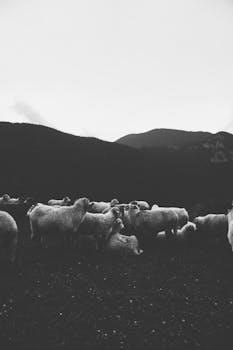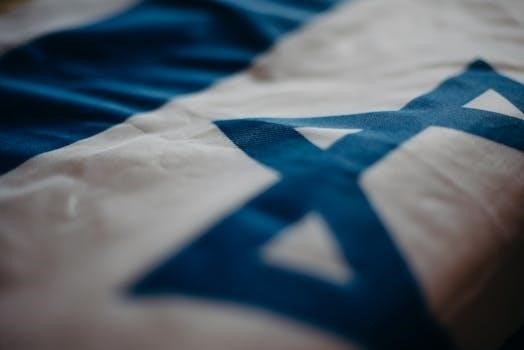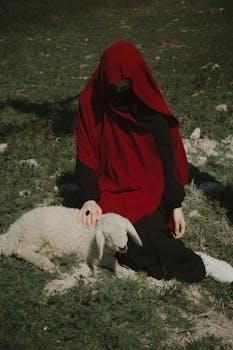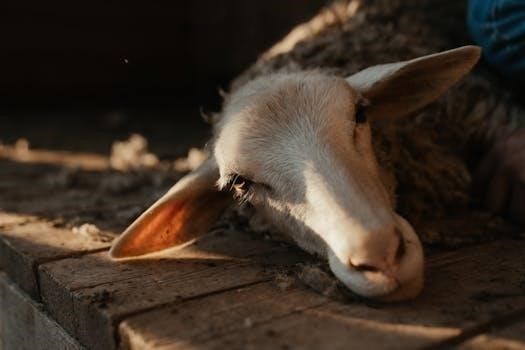The Passover lamb, also called the Paschal lamb, is a sacrifice mandated by the Torah for the Israelites to ritually slaughter on Passover evening. It commemorates the Exodus from Egypt, a pivotal event in Jewish history, and the lamb’s blood played a crucial role in the story.
Significance of the Passover Lamb
The Passover lamb holds profound significance as a central element of the Passover narrative and a powerful symbol within Judaism. It is not merely a sacrificial offering but a representation of deliverance and redemption. The lamb’s sacrifice is inextricably linked to the story of the Exodus from Egypt, where its blood marked the doorposts of the Israelite homes, protecting them from the tenth plague, the death of the firstborn. This act of divine intervention spared the Israelites while bringing judgment upon their oppressors. The Passover lamb, therefore, embodies the idea of God’s covenant and his unwavering commitment to his people. It’s a reminder of the liberation from slavery and the beginning of a journey towards freedom. Beyond its historical context, the Passover lamb continues to be a symbol of hope, protection, and God’s saving grace. It serves as a focal point for the Passover Seder, connecting generations of Jews to their ancestral heritage and the miraculous events that shaped their identity. The lamb’s sacrifice is a vivid reminder of the cost of freedom and the importance of remembering and celebrating God’s faithfulness.

Biblical Instructions
The Book of Exodus provides detailed instructions for the Passover lamb. God commanded the selection of a lamb on the tenth day of the first month and its sacrifice on the fourteenth day, outlining specific rituals.
Selection of the Lamb
The selection of the Passover lamb was a meticulous process, requiring an unblemished, one-year-old male lamb or goat. This signified purity and perfection, highlighting the sacred nature of the offering. Families or communities would choose their animal on the tenth day of the first month, carefully observing its condition for any flaws or defects. Keeping the lamb for four days before the sacrifice allowed for a deeper connection to the animal and the spiritual significance of the ritual. The lamb was brought into the home, where it was lovingly cared for, emphasizing the importance of this family sacrifice; This process also served as a period of reflection and preparation for the Passover observance, where the lamb would be a central element of the Seder.
Timing of the Sacrifice
The timing of the Passover lamb sacrifice was very specific, occurring on the fourteenth day of the first month, at sundown. This precise timing was crucial, as it marked the transition from day to night, and it was this time that the lambs were slaughtered. The slaughtering itself would take place at sunset, marking the beginning of Passover. This timing was not arbitrary; it was carefully chosen in accordance with the biblical instructions. The sacrifice had to happen before the evening meal, the Seder, which occurs after midnight. The lambs were typically slaughtered at the Temple, or at the home, and this precise timing served to further emphasize the importance and solemnity of the occasion, making it a significant part of the Passover observance. The day of the sacrifice was a day of preparation and anticipation, building up to the evening’s commemoration. The time was set by the priests.
Slaughtering the Lamb
The slaughtering of the Passover lamb was a ritual performed with great care. Under the supervision of priests, a family representative would carry out the slaughter, catching the blood in a basin. This blood was then used in a significant part of the Passover ritual, as a sign of protection. The lamb was killed at sundown, a time that marked a transition and held spiritual significance. After slaughter, the animal was carefully skinned and opened. The slaughtering process was not just a physical act; it was a sacred one, a crucial part of the Passover observance, and a reminder of God’s intervention in their lives. The timing of the slaughter was specific, at sundown, highlighting the importance of following the prescribed procedure. The blood was then sprinkled on the doorposts of the tent, which symbolized a protection.

Preparation of the Lamb
The preparation of the Passover lamb involved specific methods. Roasting the lamb whole over a fire was the primary method, according to Torah guidelines. This method was crucial, with specific instructions followed for its proper preparation and consumption.
Roasting the Lamb
The Passover lamb, after being sacrificed, was traditionally prepared by roasting whole over a fire. This method of cooking was specifically instructed in the Torah, ensuring that the lamb was not boiled or prepared in any other way. The roasting process involved carefully positioning the lamb so that it would cook evenly, and the heat would penetrate all parts of the meat. The goal was to achieve a succulent and tender result that would be suitable for the sacred meal. The specific method of roasting contributed to the unique flavor and texture of the Passover lamb. The importance of roasting with fire is emphasized in the guidelines laid out in the Torah, highlighting the ritualistic nature of the meal and the need for strict adherence to tradition. While there might be slight differences in seasoning, the fundamental method of roasting the lamb remains an important aspect of Passover.
Eating the Lamb
The consumption of the Passover lamb was a communal act, with the entire group partaking together, emphasizing unity and shared experience. The lamb had to be eaten entirely that same evening, and nothing could remain overnight, underscoring the immediacy and sacredness of the ritual. Each participant was required to eat a portion of the lamb, at least as large as an olive, ensuring that everyone had a share in the sacrificial meal. The act of eating was not merely sustenance but a profound symbolic gesture of participating in the Passover narrative. It was a moment of remembrance, reflecting on the deliverance from Egypt. The rules for eating the lamb required all those participating to stay together throughout the meal, reinforcing the sense of community and shared identity, central to the Passover celebration. This communal consumption further solidified their bond and their connection to the historic event.

Symbolism and Ritual
The Passover lamb ritual is rich with symbolism, connecting the Israelites to their history. The blood on doorposts, the eating of unleavened bread and bitter herbs, all have deep meanings that resonate with the story of the Exodus and freedom.
Blood on Doorposts
The application of the lamb’s blood to the doorposts is a central element of the Passover narrative, symbolizing protection and redemption. According to the Book of Exodus, God instructed the Israelites to mark their doorframes with the blood of the sacrificed lamb as a sign. This act of faith and obedience was meant to shield their households from the tenth and final plague, the death of the firstborn, which was to strike all of Egypt. The blood, applied with a bunch of hyssop, served as a visible distinction between the homes of the Israelites and those of the Egyptians. It was not merely a physical act but a profound spiritual declaration of their covenant with God. This ritual, therefore, represents divine protection and the initiation of the Israelites’ liberation from slavery. The blood, seen as a sacrifice, paved the way for their freedom and set the stage for their journey towards the Promised Land. This tradition is still observed and remembered during the Passover Seder, serving as a reminder of God’s deliverance and the significance of the lamb’s sacrifice.
Unleavened Bread and Bitter Herbs
The consumption of unleavened bread (matzah) and bitter herbs (maror) alongside the Passover lamb is an integral part of the Seder meal, each carrying significant symbolic weight. Unleavened bread, made without yeast, represents the haste with which the Israelites had to leave Egypt, not having time for their dough to rise. This symbolizes the urgency and immediacy of their liberation, a flight so swift that they could not even prepare bread in the traditional manner. The bitter herbs, on the other hand, serve as a reminder of the bitterness of slavery and the hardships endured by the Israelites during their time in Egypt. This consumption of bitter herbs brings the harsh realities of their bondage to the forefront, creating a somber contrast to the joy of freedom. Together, the matzah and maror encapsulate the dual nature of the Exodus, a journey marked by both suffering and liberation, and they are a testament to the trials faced before the promise of freedom was realized. They stand as powerful symbols of remembrance and gratitude.

Modern Interpretations
Today, while the Temple sacrifice is not practiced, the Passover lamb is interpreted symbolically. Many modern recipes adapt traditional methods, focusing on roasting or other cooking techniques. The meal emphasizes remembrance and tradition.
Contemporary Passover Lamb Recipes
Modern Passover lamb recipes offer diverse approaches, adapting traditional roasting methods with contemporary flavors. A popular choice is slow-cooked lamb, ensuring tenderness and rich flavors, often infused with herbs like rosemary and thyme. Some recipes incorporate Mediterranean influences, using ingredients such as garlic, olive oil, and lemon to create a flavorful marinade. Another approach involves using a leg of lamb, which can be roasted whole or cut into smaller portions. Many modern interpretations focus on creating a memorable, flavorful centerpiece for the Seder meal. There are also options for those who prefer lamb chops, which can be prepared with a variety of seasonings. Some contemporary recipes even explore the use of pickled cherries, adding a unique sweet and tangy element to the dish. Regardless of the specific recipe, the core aim remains to honor tradition while creating a delicious and meaningful meal for the Passover celebration. Chefs also adapt recipes to various dietary needs and preferences.

Leave a Reply
You must be logged in to post a comment.